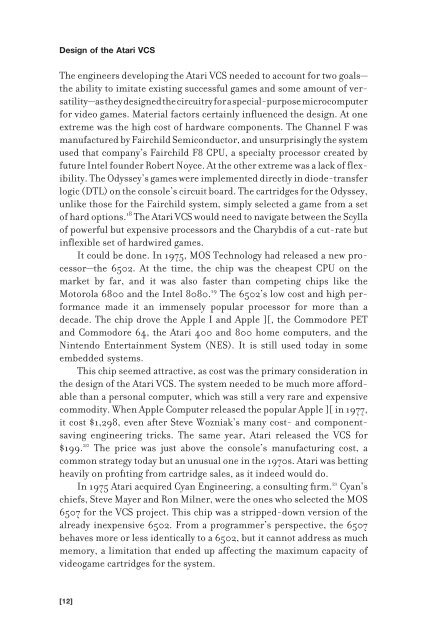Racing the Beam : the Atari Video Computer System - Index of
Racing the Beam : the Atari Video Computer System - Index of
Racing the Beam : the Atari Video Computer System - Index of
Create successful ePaper yourself
Turn your PDF publications into a flip-book with our unique Google optimized e-Paper software.
Design <strong>of</strong> <strong>the</strong> <strong>Atari</strong> VCS<br />
The engineers developing <strong>the</strong> <strong>Atari</strong> VCS needed to account for two goals—<br />
<strong>the</strong> ability to imitate existing successful games and some amount <strong>of</strong> versatility—as<br />
<strong>the</strong>y designed <strong>the</strong> circuitry for a special-purpose microcomputer<br />
for video games. Material factors certainly infl uenced <strong>the</strong> design. At one<br />
extreme was <strong>the</strong> high cost <strong>of</strong> hardware components. The Channel F was<br />
manufactured by Fairchild Semiconductor, and unsurprisingly <strong>the</strong> system<br />
used that company’s Fairchild F8 CPU, a specialty processor created by<br />
future Intel founder Robert Noyce. At <strong>the</strong> o<strong>the</strong>r extreme was a lack <strong>of</strong> fl exibility.<br />
The Odyssey’s games were implemented directly in diode-transfer<br />
logic (DTL) on <strong>the</strong> console’s circuit board. The cartridges for <strong>the</strong> Odyssey,<br />
unlike those for <strong>the</strong> Fairchild system, simply selected a game from a set<br />
<strong>of</strong> hard options. 18 The <strong>Atari</strong> VCS would need to navigate between <strong>the</strong> Scylla<br />
<strong>of</strong> powerful but expensive processors and <strong>the</strong> Charybdis <strong>of</strong> a cut-rate but<br />
infl exible set <strong>of</strong> hardwired games.<br />
It could be done. In 1975, MOS Technology had released a new processor—<strong>the</strong><br />
6502. At <strong>the</strong> time, <strong>the</strong> chip was <strong>the</strong> cheapest CPU on <strong>the</strong><br />
market by far, and it was also faster than competing chips like <strong>the</strong><br />
Motorola 6800 and <strong>the</strong> Intel 8080. 19 The 6502’s low cost and high performance<br />
made it an immensely popular processor for more than a<br />
decade. The chip drove <strong>the</strong> Apple I and Apple ][, <strong>the</strong> Commodore PET<br />
and Commodore 64, <strong>the</strong> <strong>Atari</strong> 400 and 800 home computers, and <strong>the</strong><br />
Nintendo Entertainment <strong>System</strong> (NES). It is still used today in some<br />
embedded systems.<br />
This chip seemed attractive, as cost was <strong>the</strong> primary consideration in<br />
<strong>the</strong> design <strong>of</strong> <strong>the</strong> <strong>Atari</strong> VCS. The system needed to be much more affordable<br />
than a personal computer, which was still a very rare and expensive<br />
commodity. When Apple <strong>Computer</strong> released <strong>the</strong> popular Apple ][ in 1977,<br />
it cost $1,298, even after Steve Wozniak’s many cost- and componentsaving<br />
engineering tricks. The same year, <strong>Atari</strong> released <strong>the</strong> VCS for<br />
$199. 20 The price was just above <strong>the</strong> console’s manufacturing cost, a<br />
common strategy today but an unusual one in <strong>the</strong> 1970s. <strong>Atari</strong> was betting<br />
heavily on pr<strong>of</strong>i ting from cartridge sales, as it indeed would do.<br />
In 1975 <strong>Atari</strong> acquired Cyan Engineering, a consulting fi rm. 21 Cyan’s<br />
chiefs, Steve Mayer and Ron Milner, were <strong>the</strong> ones who selected <strong>the</strong> MOS<br />
6507 for <strong>the</strong> VCS project. This chip was a stripped-down version <strong>of</strong> <strong>the</strong><br />
already inexpensive 6502. From a programmer’s perspective, <strong>the</strong> 6507<br />
behaves more or less identically to a 6502, but it cannot address as much<br />
memory, a limitation that ended up affecting <strong>the</strong> maximum capacity <strong>of</strong><br />
videogame cartridges for <strong>the</strong> system.<br />
[12]


